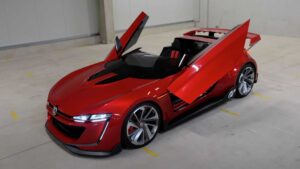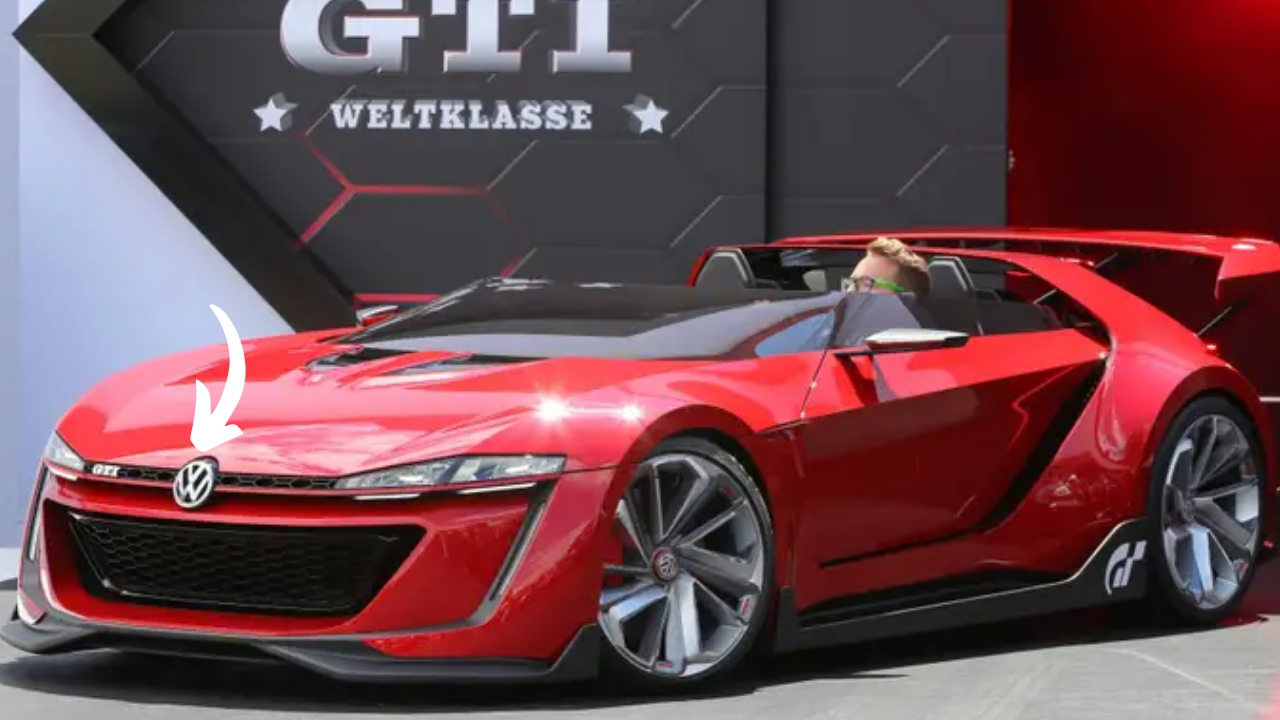The Volkswagen GTI has long been a symbol of performance, practicality, and driving pleasure, captivating enthusiasts since its debut in 1975. Over the decades, the GTI badge has adorned various models, from hot hatches to limited-edition concepts, each pushing the boundaries of what a compact car can achieve. Among these, the GTI Cabrio Vision stands out as a bold experiment—a concept that reimagines the convertible experience by offering open-air driving without sacrificing the structural integrity of a fixed roof. This article delves into the GTI Cabrio Vision’s innovative design, its place in Volkswagen’s storied GTI lineage, and its potential influence on future automotive trends.
The Genesis of the GTI Cabrio Vision
The GTI Cabrio Vision first captured attention as a concept born from Volkswagen’s collaboration with the Gran Turismo video game series, specifically the Vision Gran Turismo project. Launched in 2014 at the Wörthersee Treffen, an annual gathering of Volkswagen enthusiasts, the GTI Cabrio Vision was a response to Sony’s invitation to create a car celebrating 15 years of Gran Turismo. Unlike traditional concepts, this vehicle was designed with both virtual and real-world appeal, blending futuristic aesthetics with the GTI’s performance heritage.
The concept originated from an internal competition among Volkswagen’s young designers, spearheaded by style manager Klaus Bischoff. The brief was simple yet ambitious: create a GTI that embodies open-air freedom while retaining the structural rigidity and sporty dynamics of a fixed-roof model. The result was a roadster configuration that defied conventional convertible designs, featuring a retractable glass panel system inspired by earlier experiments like the 2007 Polo GTI Cabrio concept by Karmann.
Innovative Design: Open Air, Roof Stays
The GTI Cabrio Vision’s defining feature is its unique roof system. Unlike traditional convertibles that rely on folding soft tops or retractable hardtops, this concept employs sliding glass panels integrated into a fixed carbon-fiber roof structure. The panels slide back electronically, allowing occupants to enjoy an open-air experience while the roof’s framework remains in place, preserving chassis rigidity and safety. This design addresses a common drawback of convertibles: compromised structural integrity due to the absence of a fixed roof, which often leads to scuttle shake and reduced handling precision.
The roof mechanism is both functional and visually striking. When closed, the glass panels provide a panoramic view, enhancing the cabin’s sense of space. When retracted, they stow neatly behind the rear seats, creating an open-top experience without the bulk of traditional convertible mechanisms. The fixed roof stays also incorporate an automatic rollover protection system, a nod to safety-conscious engineering. This innovative approach draws parallels to the 2007 Polo GTI Cabrio, which featured a similar sliding glass system, though the GTI Cabrio Vision takes it further with advanced materials and electronics.
The exterior design is unmistakably GTI, with aggressive lines, a low stance, and signature red accents. The concept is based on the Modular Querbaukasten (MQB) platform, which provides a lightweight yet rigid foundation. The body is crafted from two carbon-fiber shells separated by a central spine, reducing weight while enhancing strength. The front fascia features a honeycomb grille with red pinstriping, a tribute to the original MK1 GTI, while the rear boasts dual central exhausts and smoked LED taillights. Distinctive 20-inch alloy wheels with red accents complete the look, giving the car a wider, more planted stance.
Performance: Power Meets Precision
Under the hood, the GTI Cabrio Vision is powered by a 3.0-liter V6 TSI engine with twin turbochargers, delivering an impressive 503 horsepower and 560 Nm of torque. This powerplant is paired with a seven-speed dual-clutch DSG gearbox, enabling the roadster to accelerate from 0 to 100 km/h in just 3.6 seconds and reach a top speed of 310 km/h (190 mph). The all-wheel-drive system ensures optimal traction, making the car as capable on a racetrack as it is on a scenic coastal road.

The suspension is tuned for performance, with adjustable dampers to balance comfort and agility. While the concept’s low center of gravity and wide track enhance cornering, the MQB platform’s versatility allows for precise handling without sacrificing ride quality. The brakes, featuring large ventilated discs, provide confident stopping power, essential for a car with such potent performance.
The GTI Cabrio Vision’s virtual presence in Gran Turismo 6, Sport, and 7 allows players to experience its dynamics in a simulated environment. The game’s physics engine highlights the car’s responsive steering and balanced chassis, offering a glimpse of what a production version might feel like. However, the concept’s extreme performance suggests it was designed more as a halo model than a practical road car, aligning with the Vision Gran Turismo’s ethos of pushing boundaries.
Interior: A Blend of Sport and Luxury
Inside, the GTI Cabrio Vision combines race-inspired elements with premium materials. The cabin seats two, with heavily bolstered sports seats upholstered in Alcantara and classic Jacara tartan cloth—a nod to GTI heritage. Red stitching accents the leather-wrapped steering wheel, gear lever, and handbrake, reinforcing the car’s sporty character. The dashboard features a digital instrument cluster and a minimalist center console, prioritizing driver focus.
The open-air experience is amplified by the sliding glass roof, which floods the cabin with light and air. Even with the panels closed, the glass creates a sense of openness, while the black roof lining and pillar trims maintain a cohesive aesthetic. Practicality is not overlooked: the rear seats fold to expand cargo space, and the boot offers 250 liters of capacity, comparable to the MK6 Golf GTI Cabriolet.
Safety features include front and side airbags, a driver’s knee airbag, and the aforementioned rollover protection system. While the concept hasn’t been crash-tested, its shared technology with the five-star-rated Golf hatch suggests robust occupant protection.
The Legacy of GTI Convertibles
The GTI Cabrio Vision isn’t Volkswagen’s first foray into open-top GTIs. The MK1 Golf GTI Cabriolet, produced until 1993, was a cult classic, blending hot-hatch performance with wind-in-the-hair thrills. The MK6 Golf GTI Cabriolet, launched in 2012, revived the concept with a 2.0-liter turbocharged engine producing 210 horsepower and a folding fabric roof that lowered in 9.5 seconds. Both models were praised for their refinement and driving dynamics, though high production costs limited their market reach.
The 2007 Polo GTI Cabrio concept, built by Karmann, was a precursor to the GTI Cabrio Vision’s roof design. Its retractable fabric roof with sliding glass panels allowed open-air driving without fully stowing the top, a feature that balanced practicality and aesthetics. However, like many concepts, it never reached production due to cost constraints and the impending launch of the fifth-generation Polo in 2009.
The GTI Cabrio Vision builds on this legacy, merging the spirit of past GTI convertibles with cutting-edge technology. Its carbon-fiber construction and advanced roof system reflect Volkswagen’s ambition to innovate, even if the concept remains a one-off.
Why It Never Reached Production
Despite its acclaim, the GTI Cabrio Vision was never intended for production. The Vision Gran Turismo project prioritizes bold, futuristic designs over commercial viability, and the GTI Cabrio Vision’s exotic materials and extreme performance made it prohibitively expensive for mass production. Additionally, the convertible market has dwindled in recent years, with Volkswagen discontinuing models like the T-Roc Cabriolet.
The concept’s niche appeal and high development costs echo the fate of earlier GTI convertibles. Turning a hatchback into a convertible requires significant structural reinforcement, increasing weight and expense. For a brand focused on electrification and mainstream models, the business case for a low-volume roadster was weak.
Influence on Future Volkswagens
While the GTI Cabrio Vision remains a concept, its innovations could influence future Volkswagen models. The sliding glass roof system offers a compelling alternative to traditional convertibles, potentially applicable to premium SUVs or electric vehicles where structural rigidity is critical. The use of carbon fiber and the MQB platform’s versatility highlight Volkswagen’s commitment to lightweight, modular architectures, which underpin models like the ID.3 GTX and Golf R.
The concept also underscores the enduring appeal of the GTI brand. As Volkswagen transitions to electric performance models, the GTI badge will likely persist, with future concepts possibly blending open-air designs with zero-emission powertrains. The ID.2all Concept EV, revealed in 2023, hints at an electric GTI, and a roadster variant could revive the Cabrio Vision’s spirit in a sustainable form.
Looking Forward
The Volkswagen GTI Cabrio Vision is a testament to the GTI’s enduring legacy and Volkswagen’s willingness to experiment. Its innovative roof system, blistering performance, and striking design make it a standout in the Vision Gran Turismo lineup, even if it never graced showrooms. By blending open-air freedom with fixed-roof stability, the concept challenges conventional convertible design, offering a glimpse of what future GTIs could achieve. For enthusiasts, the GTI Cabrio Vision remains a tantalizing “what could have been,” a bold vision that keeps the GTI spirit alive in both virtual and real worlds.
